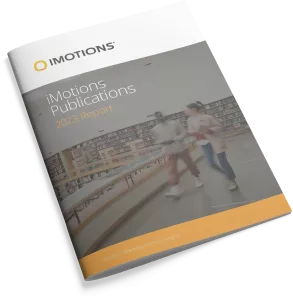-
Role of Accentuation in the Selection/Rejection Task Framing Effect
Abstract: Procedure invariance is a basic assumption of rational theories of choice, however, it has been shown to be violated: Different response modes, or task frames, sometimes reveal opposite preferences. The current study focused on selection and rejection task frames, involving a unique type of problem with enriched and impoverished options, which has previously led […]
-
Psychophysiological Responses to Short-Term Cooling During a Simulated Monotonous driving task
Abstract: For drivers on monotonous routes, cognitive fatigue causes discomfort and poses an important risk for traffic safety. Countermeasures against this type of fatigue are required and thermal stimulation is one intervention method. Surprisingly, there are hardly studies available to measure the effect of cooling while driving. Hence, to better understand the effect of short-term cooling […]
-
Maternal gaze to the infant face: Effects of infant age and facial configuration during mother-infant engagement in the first nine weeks
Background: Adult gaze plays an important role in early infant development, and infants are highly sensitive to its presence and direction. Little is known, however, about how adults look at infants while interacting with them. Using eye-tracking technology, this study investigated maternal gaze during naturalistic interactions, and how it was influenced by infant age, focusing on […]
-
Positive Affect Is Associated With Reduced Fixation in a Realistic Medical Simulation
Objective: This study extends previous research by exploring the association between mood states (i.e., positive and negative affect) and fixation in practicing anesthetists using a realistic medical simulation. Background: The impact of practitioner emotional states on fixation is a neglected area of research. Emerging evidence is demonstrating the role of positive affect in facilitating problem solving and […]
-
Real-Time Sensing of Trust in Human-Machine Interaction
Abstract: Human trust in automation plays an important role in successful interactions between humans and machines. To design intelligent machines that can respond to changes in human trust, real-time sensing of trust level is needed. In this paper, we describe an empirical trust sensor model that maps psychophysiological measurements to human trust level. The use of […]
-
What makes a smiling face look happy? Visual saliency, distinctiveness, and affect
Abstract: We investigated the relative contribution of (a) perceptual (eyes and mouth visual saliency), (b) conceptual or categorical (eye expression distinctiveness), and (c) affective (rated valence and arousal) factors, and (d) specific morphological facial features (Action Units; AUs), to the recognition of facial happiness. The face stimuli conveyed truly happy expressions with a smiling mouth […]
-
HuSIS: A Dedicated Space for Studying Human Interactions
Abstract: The Human-Surrogate Interaction Space (HuSIS) consists of a dedicated physical space, structures, and components designed specifically for carrying out controlled studies related to human-surrogate interactions. This article discusses the primary factors considered in the HuSIS design and the benefits of the common data-collection and analysis framework for HuSIS research.
-
Automatic expression recognition and expertise prediction in Bharatnatyam
Abstract: Bharatnatyam is an ancient Indian Classical Dance form consisting of complex postures and expressions. One of the main challenges in this dance form is to perform expression recognition and use the resulting data to predict the expertise of a test dancer. In this paper, expression recognition is carried out for the 6 basic expressions […]
-
Alexithymia, but Not Autism Spectrum Disorder, May Be Related to the Production of Emotional Facial Expressions
Abstract: Background: A prominent diagnostic criterion of autism spectrum disorder (ASD) relates to the abnormal or diminished use of facial expressions. Yet little is known about the mechanisms that contribute to this feature of ASD. Methods: We showed children with and without ASD emotionally charged video clips in order to parse out individual differences in spontaneous production […]
-
Deep Multimodal Fusion for Persuasiveness Prediction
Abstract: Persuasiveness is a high-level personality trait that quantifies the influence a speaker has on the beliefs, attitudes, intentions , motivations, and behavior of the audience. With social multimedia becoming an important channel in propagating ideas and opinions, analyzing persuasiveness is very important. In this work, we use the publicly available Persuasive Opinion Multimedia (POM) […]
Research Report 2023
In-depth look at the scientific landscape as powered by iMotions software, showcasing groundbreaking research and the impact of our tools in various scientific and industrial fields.

Share Your Research

850+ universities worldwide with an iMotions human behavior lab
73 of the top 100 highest ranked universities
710+ published research papers using iMotions
iMotions is used for some of the most interesting human behavior research studies carried out by top researchers around the world. Contact us to have your publication featured here.
The authors of these publications have used iMotions as a software tool within their research.
“Software should be cited on the same basis as any other research product such as a paper or a book; that is, authors should cite the appropriate set of software products just as they cite the appropriate set of papers” (Katz et al., 2020).
We therefore encourage you to cite the use of iMotions where appropriate.
How to cite iMotions
APA
iMotions (10), iMotions A/S, Copenhagen, Denmark, (2024).
Note: adjust the version and year where relevant.
5 Most Popular Blogs
Learn How to Conduct Human Behavior Research with iMotions
Publications
Read publications made possible with iMotions
Blog
Get inspired and learn more from our expert content writers
Newsletter
A monthly close up of latest product and research news





